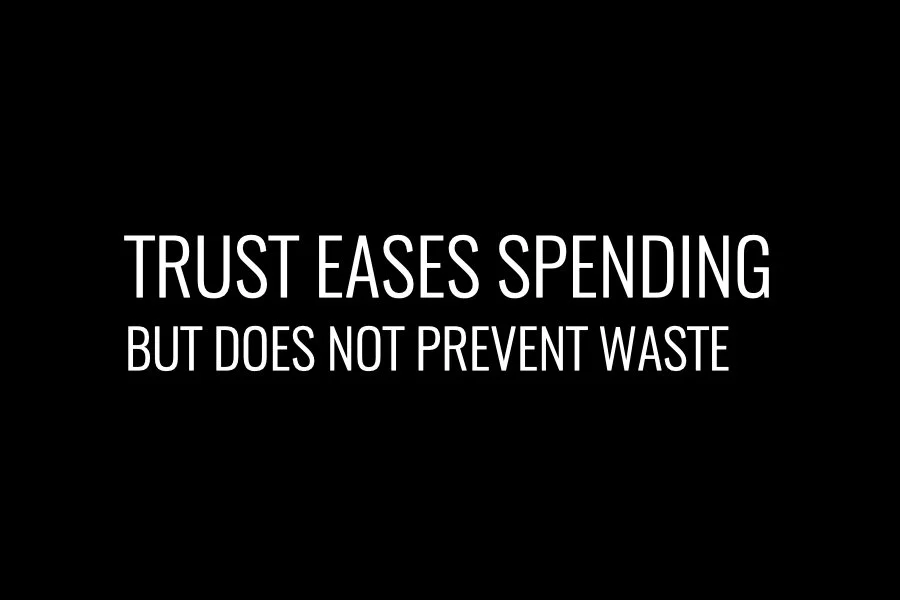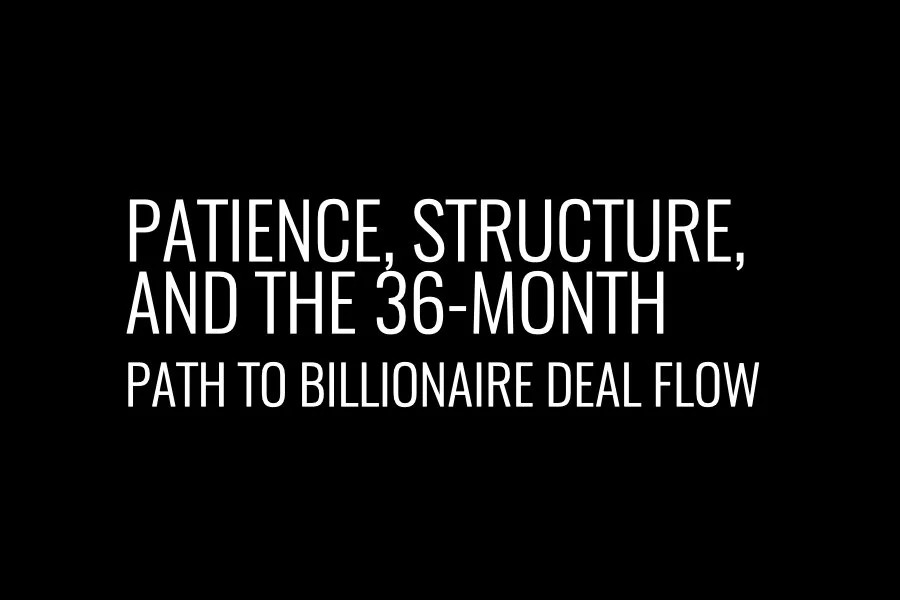It may surprise you, but UHNWI prospecting relies on consistency and patience
It’s a little odd to have to write this—something most would call obvious. Yet two dozen recent meetings, held as part of our annual market sweep in search of new long-term partners, were a reminder: don’t look at the world through the lens of your own presumptions about what’s “obvious.” Not everything obvious is actually obvious.
Here’s the reality: many people have a distorted sense of how long it takes to build a credit of trust among UHNWIs. The truth (and this is a fact) is that sometimes it takes 10–15 touchpoints just to get a “No”—which is only a “no” or an “unsubscribe.” Positive replies can require dozens of contacts. And those touchpoints must be high-quality, not intrusive spam. This is one of those things that seems obvious yet remains non-obvious to others—more on that in a moment.
Say it takes twenty touchpoints to get the first “I’m interested—tell me more” in response to a campaign. If we run one cycle per month (main touchpoint + follow-up), that’s twenty months. To many of you, that timeline feels alarming. Don’t jump to conclusions. Over those twenty months, we’re engaging thousands of UHNWIs. They all receive a shared yet customized stream of information and, upon reaching their personally required critical mass for decision-making, they begin to respond. For some it will happen earlier, for others later—but this is the base case. Until then, there may be absolute silence—and that silence unnerves you. You’re ready to pay for unqualified leads, to have fruitless dialogues with intermediaries and entourages—anything but silence.
But just as money loves silence, true professionals understand its nature. Only a few are patient enough to endure this phase without stepping off the track.
That’s why we don’t do trials and treat one-time campaigns as a lottery—because in the UHNWI segment, that’s what they are. Isn’t it a jackpot to pay $10K–$20K for a one-time campaign and sell a $100M+ yacht or $50M+ residence?
We don’t rule such events out (we’ve seen these “miracles” ourselves), but our focus is long-horizon, repeatable strategy—not happenstance.
There is organic demand for luxury assets across multiple industries; it exists on its own. You don’t create it; you merely intercept those already inclined. For some, that’s enough to feel successful. Yet genuine success is in cultivating relationships with UHNWIs who will become your clients “tomorrow.” Otherwise, in the net of those who simply wait, the “catch” will shrink each year. Another obvious point: if you cover a meaningful UHNWI audience with the aim of building long-term relationships (and nothing stops you from hedging by promoting current inventory), then by the time they are ready—and that readiness will be partly your doing—they will know whom to call. No need to belabor the point; this should be clear.
Now, about the quality of those touchpoints. This is where things have truly deteriorated: automation and LLMs have turned outreach into an endless stream of irrelevant spam. Have you actually read those “masterpieces”? Our logic is simple: when someone creates content that takes a single click to send, they think about substance at a basic sanitary level, from their own best guess of what it “should” be—plus ChatGPT (or any LLM of choice) riding to the rescue, which of course “knows” how to do it right. Amusing. In that setup, the cost of a mistake is just the time wasted on a bad draft. In addition, you may spend a few, a dozen, or a hundred dollars to boost it. And then you ask, “Where did my dollars fly to?”
When you, as we do at UHNWI data, send thousands of messages by hand—copy-pasting customized elements into a shared draft (name, subject line, salutation, etc.)—you spend hours of monotonous work every day. Try sending 500 emails: Forward → remove trailing headers → copy/paste the subject → copy/paste the recipient’s name (Dear Mr. X, Dear Ms. Y) → send. Repeat that 500 times. Time it: three to four hours at a good clip. Keep going until you’ve sent 6,000 emails—twelve days. And that’s only phase one. Follow-ups are easier—at least you skip the subject line step. Over this stretch you think again and again about content quality, efficacy, usefulness, and appeal to a UHNWI recipient. The cost of a mistake? Twenty-four days of several hours each. Not counting analytics and record-keeping. Hours…
Some will say, “You invented your own problem and now present it as heroism.” The point is, automation in UHNWI prospecting does not work. It. Does. Not. Work. Automation was built to serve existing clients, not to prospect new ones—though there are exceptions if you sell chips, socks, or any other mass-market, low-ticket physical or digital product. At huge volumes, automation can pay. But if you want to develop the UHNWI market, it won’t.
First, modern filters won’t let your emails through: most will land in spam or be blocked. Unless you seriously build your own mail infrastructure with a substantial technical team, no platform is likely to allow you to upload a “cold” list of 2,000 billionaires without proof of provenance. And you will not be able to prove that all of them opted in—100% guaranteed. No one has 2,000 billionaires as subscribers—not even Google or Apple, let alone anyone else. What’s left are questionable lead-gen platforms (which will likely steal your database) where you’ll either be blocked quickly (“thanks for the contacts—goodbye”), or you’ll open a dozen accounts and send in tiny batches—yet the odds that your messages will land before UHNWIs rather than in spam are negligible. Seriously—do you think we haven’t tried? Even a fully independent platform with its own mail servers and all the trimmings doesn’t work in the UHNWI segment at the prospecting stage.
Someone will object: “The fact that you tried doesn’t mean you did it right.” Perhaps. If you’ve succeeded—congratulations. In that case, why are you reading this? To refute it and prove it’s possible? Excellent. If you have an automated system with a mailing list that includes 2,000 billionaires, 1,500 centimillionaires, and several thousand $10M+ individuals—and proof in the form of hundreds of replies from that audience (screenshots—the kind we have)—we’re ready to buy your capability wholesale. Yet what we typically see are lead peddlers for underwear, socks, and $15 subscriptions—not for yachts and jets. It’s laughable.
Automation also tempts you to send more than is prudent; recipients quickly overheat and unsubscribe or block you. Understand this: there is no short or fast path. In operational terms, you can’t skip the courtship phase. This is long-form courting: you prove you’re “the one,” then, at the right moment, you make an offer and hope to hear “yes.” That is the real scenario. If you pay for instant results, it’s called something else (you know what).
You have to feel the audience and know whom you’re dealing with. Whatever you think of yourself—no matter how magnificent your offer seems, no matter how elegantly it’s written in co-authorship with AI—don’t expect an immediate surge of interest. Believe in the best outcome if you wish, but assess your odds soberly. The real picture: one year for the initial acquaintance—even if “everyone already knows you.” Exceptions: hot markets, below-market pricing (rare but obviously attractive), and luck.
Your relationship with a UHNWI audience is a long history of trial and error, anxious waiting, irritating silence—and then back again. But if your offer truly has a market, sales will come. And, again, nothing stops you from hedging risk and hunting organic demand with the same strategies you already use.
One last point: trust. To take trust off the table, you need sufficient proof that the strategy works. You must also know what counts as proof. The primary proof is, of course, sales. Yet the distrust in many of you is so strong you don’t even believe in the seller’s success. “You’re in cahoots…” Ladies and gentlemen, what’s going on with you all? You don’t believe obvious examples or the references from clients who’ve used our service for years. It borders on absurd: companies we’ve discussed working with have had listings sold thanks to our service; owners of those listings sent direct inquiries about other assets we promote; and they sat down for in-person meetings with sellers’ representatives—meetings arranged because of our service. Dozens of such cases. All you need is to ask your client: did it happen or not? It’s transparent—what more do you need?
All I hear is: “Too good to be true!” That’s the problem. You’re playing by the rules of those who want you to keep paying to promote on their platforms. You lack any other experience. There’s nothing surprising in what I’m saying: we’ve simply been doing this for a very long time, and to us (and many of our clients) it’s obvious. If you don’t want to accept reality, there’s nothing we can do. But let’s be honest: who loses more? Clearly, if you’re reading this, your sales aren’t perfect. Those who are doing well are busy with more pleasant things. Answer a simple question: why read this if you’re not prepared to believe it? Better go read about the “effectiveness of digital platforms” for UHNWI prospecting—at least that will yield some result. Then you’ll boost another post or buy more Google Ads—and everything will be as always.
It’s hard to believe this needed to be written. It’s so obvious that it’s almost sad how much noise has clouded your vision. But sooner or later, once you reach a critical mass of sufficient information, you’ll see clearly. Unlike you, we have extraordinary patience.



